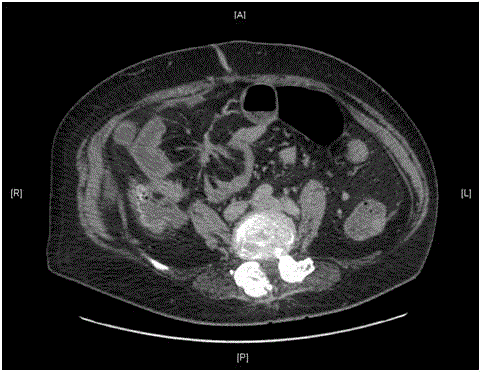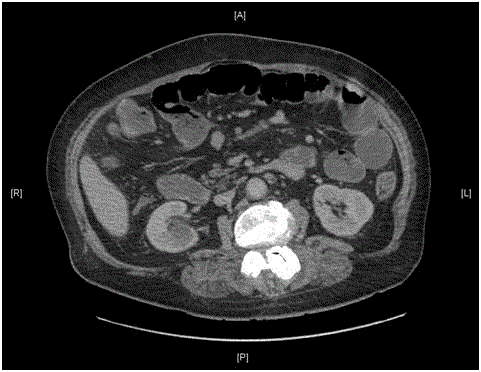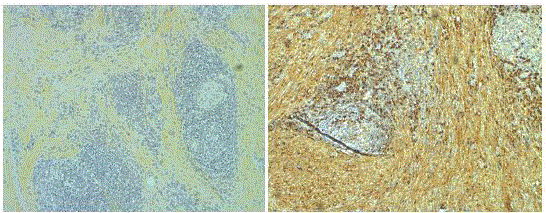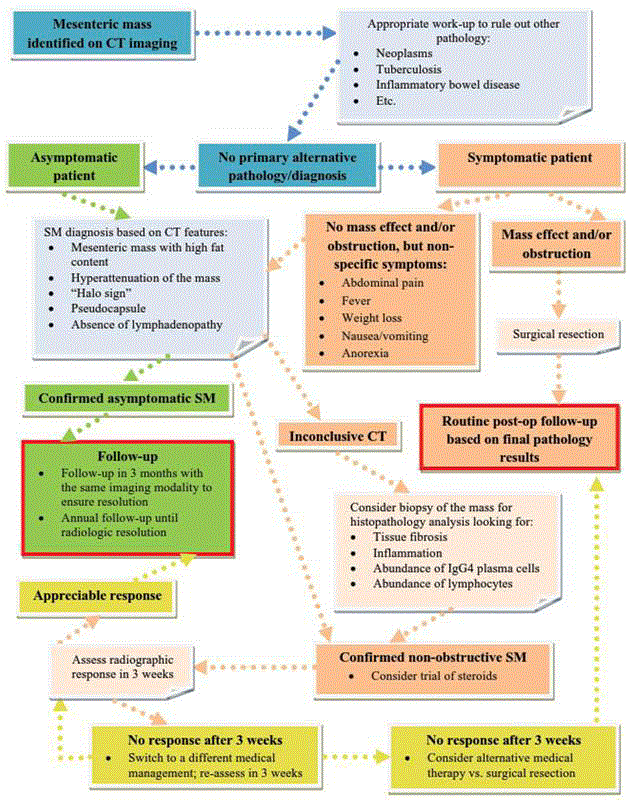Case Report
Mechanical Small Bowel Obstruction from Sclerosing Mesenteritis: Case Report and Review of the Literature
Ekaterina Kouzmina, Zuhaib M Mir and Boris Zevin*
Department of Surgery, Queen’s University, Kingston, ON, Canada
*Corresponding author: Boris Zevin, Department of Surgery, Queen’s University, Kingston Health Sciences Centre 76 Stuart Street, Burr 2 Kingston, ON, K7L 2V7, Canada
Published: 21 Aug, 2017
Cite this article as: Kouzmina E, Mir ZM, Zevin B.
Mechanical Small Bowel Obstruction
from Sclerosing Mesenteritis: Case
Report and Review of the Literature.
Clin Surg. 2017; 2: 1596.
Abstract
Sclerosing Mesenteritis (SM) is a rare inflammatory disorder of the mesentery that demonstrates a predilection for males in their 6th and 7th decades of life. Symptomatic patients often have nonspecific complaints such as vague abdominal pain, bloating, nausea, vomiting; while asymptomatic patients typically present with an incidental finding on abdominal imaging performed for other reasons. Herein, we present the case of a 61-year-old male with SM, who presented with a mechanical small bowel obstruction from what was initially thought to be a neuroendocrine tumor. We review current evidence regarding the diagnosis of SM and propose an algorithm for management of symptomatic and asymptomatic patients.
Introduction
Sclerosing Mesenteritis (SM) is a rare inflammatory disorder of the mesentery, with a quoted prevalence of 0.16% to 7.80% based on Computed Tomography (CT) imaging; post-mortem studies have placed the prevalence at 1.0% [1-4]. It was first described over 100 years ago as a variant of disorder under the broader family of peritoneal panniculitis; however, there is still difficulty with accurate diagnosis of SM and a paucity of guidelines for management of this rare condition [1]. Sclerosing mesenteritis has three subtypes: mesenteric lipodystrophy, mesenteric panniculitis, and retractile mesenteritis [2,5,6]. The differentiation between these three subtypes is based on the pathologic examination of the specimen as radiologic differentiation is difficult to perform and is not as reliable as tissue analysis. Specific histopathologic parameters include the amount of fat necrosis, fibrosis, and cellular invasion of the tissue [2,5,6]. As such, SM predominantly affects older adults in their 60s and 70s, however, individual cases of patients in their 20s and 30s have been reported [1,3,7,8]. SM is twice as common in males as in females [1,3,7,8]. Asymptomatic patients have SM discovered incidentally on abdominal imaging performed for other reasons, while symptomatic patients usually have non-specific symptoms including abdominal pain, fever, weight loss, nausea/vomiting, and anorexia [1-4,6,9]. These non-specific symptoms are hypothesized to be related to either the inflammatory etiology of SM or the mass effect of the gastrointestinal tract, which can result in complications such as a bowel obstruction [1-3,6,9]. This variability in clinical presentation and lack of management guidelines may lead to under or overtreatment of these patients. In this report, we present the case of a 61-year-old male with SM who presented with a mechanical small bowel obstruction initially thought to be secondary to a suspected neuroendocrine tumor. We summarize current evidence regarding the diagnosis of SM and propose an algorithm for the management of symptomatic and asymptomatic patients.
Clinical Case Presentation
A 61-year-old male presented to our hospital’s emergency department with a complaint of 8/10 colicky abdominal pain lasting for 2 days. He was nauseated and complained of abdominal bloating, but denied any vomiting, fevers, or chills. This gentleman did not have prior abdominal surgeries. He was not obstipated. His past medical history was significant for gastroesophageal reflux disease, hypertension, and obstructive sleep apnea, and diverticular disease, coronary artery disease managed with PCI and stenting, and chronic back pain. Physical examination demonstrated normal and stable vital signs, while the abdominal examination revealed a distended and tender abdomen without signs of peritonitis. There were no masses on deep palpation. Initial laboratory investigations showed a haemoglobin level of 132 g/L, white blood cell count of 10.2 × 109/L, platelet count of 236 × 109/L. His liver enzymes and lipase were within normal limits, but his C-reactive protein level was elevated at 139.4 mg/L. An abdominal series X-ray of the abdomen showed multiple air-fluid levels and dilated loops of bowel, suggestive of a small bowel obstruction. A subsequent CT scan demonstrated that the distended small bowel loops were centered on a stellate mesenteric soft tissue density measuring 3.8 cm, without evidence of internal calcification (Figure 1). A few mildly enlarged lymph nodes were also noted, however there were no lesions within the liver to suggest metastatic disease (Figure 2). Further investigation showed an elevated Chromogranin A level at 21.148 μg/L; the presumptive diagnosis was a partial small bowel obstruction secondary to a neuroendocrine tumor. The patient was managed non-operatively and was discharged home with a plan to proceed with a laparotomy in 1-2 weeks. At the time of his surgery, a distal small bowel resection, right hemicolectomy and lymphadenectomy was performed for the suspected neuroendocrine tumor. The final pathology demonstrated chronic inflammation, fibrosis, lymphoid aggregates and fat necrosis without evidence of malignancy. As such, these histopathologic findings were consistent with a diagnosis of SM (Figure 3). The remainder of the patient’s post-operative course was unremarkable, and he continues to do well since discharge.
Figure 1
Figure 2
Figure 3
Figure 3
Pathology images showing lymphoid aggregates and plasma cells
in the resected specimen at 100x magnification (A) routine stain; B) IgG
stain).
Discussion
The most recent literature on the condition of Sclerosing Mesenteritis was reviewed using MedLINE and EMBASE databases with search terms of “Panniculitis, Peritoneal” or "Sclerosing Mesenteritis”. Research results were limited to literature in English language, human subjects, and publication dates between March 2012 and March 2017. The search provided 83 results, which were screened for relevance. Inclusion criteria for studies mandated discussion of etiology or common presentations of SM; discussion of diagnostic criteria based on imaging or histopathological findings; and proposal of new treatments or description of successful treatments. Those studies that reiterated background knowledge without providing any guidance on treatment were excluded. Total of 20 studies were selected for full review. Eight additional studies were excluded as they briefly mentioned Sclerosing Mesenteritis and did not offer any new information. A total of 12 of studies were used as the evidence base for the proposed management algorithm of SM patients. Sclerosing Mesenteritis presents a diagnostic challenge due to its rarity and non-specific signs and symptoms. Both of these factors can result in diagnostic delay and potentially unnecessary surgical intervention. SM can be associated with prior abdominal surgery, malignancy, or autoimmune conditions such as vasculitis and rheumatic disease [4,7-9]. Patients with SM often have elevations in erythrocyte sedimentation rate, C-reactive protein, and/or serum IgG4 [1,3]; all of these markers are supportive of its inflammatory nature. Abdominal imaging with CT scanning can be helpful in differentiating SM from neuroendocrine tumors. Classic CT findings of SM are shown in Table 1 [2-6,9]. Presence of hyperattenuation, mass or 3 of more of these signs is highly suggestive of SM [3]. Our patient’s CT scan of the abdomen showed a stellate mesenteric soft tissue density measuring up to 4 cm without evidence of calcification and mildly enlarged lymph nodes, supporting the claim that SM may mimic other intraabdominal pathology [10]. In situations of diagnostic uncertainty, a more invasive approach with percutaneous biopsy or surgical resection of the mesenteric mass for histopathologic analysis can be considered [5]. Analysis of the pathology specimens of SM often demonstrates findings described in Table 1 [6,10]. Our patient underwent definitive management with bowel and mesenteric resection due to partial bowel obstruction symptoms. However, not all the patients end up in such a situation as many cases of SM may resolve without operative intervention [3,4,7]. Herein, we propose an evidence-based management algorithm for patients with SM (Figure 4). Health care professionals should be aware that SM patients may be either asymptomatic or present with very non-specific symptoms (abdominal pain, fever, weight loss, nausea/vomiting, and anorexia) [3,8]. We suggest a conservative approach without medical intervention to asymptomatic patients. These patients should be seen 3 months after their initial diagnosis with a repeat CT scan. If resolution of radiologic findings is noted, then patients can be monitored with similar imaging modality on an annual basis until complete resolution. There is a reported association of SM with malignancies such as lymphoma, colorectal, and prostate cancers [2,8,9]. Once imaging confirms resolution, no further follow-up is required. Symptomatic patients with nonobstructive SM should be considered for a course of steroids and other immunosuppressive medications with clinical and radiographic monitoring of their response to therapy. Previously reported successful steroid treatments include combinations of 125 mg of azathroipine and 5 mg of prednisolone daily; 40 mg of prednisone daily followed by tapering; 30 mg of prednisolone daily with tapering to 5 mg daily for maintenance after interval improvement on imaging [7,11,12]. Other medications that have been tried include tamoxifen, colchicine, antibiotics, methotrexate, and infliximab [1,4,5]. We recommend a trial of 3 weeks of selected treatment before switching to a different approach if there is no appreciable response. Surgical resection should be undertaken if patients do not respond to medical management, develop complications such as bowel obstruction, or if there is a concern for underlying malignancy.
Figure 4
Table 1
Conclusion
Sclerosing Mesenteritis is a rare inflammatory condition of the mesentery. An evidence-based approach for the diagnosis and management of this condition proposed in this manuscript should avoid over or under treatment. Additional research should focus on improved diagnostic accuracy and on predicting therapeutic response to alleviate the need for unnecessary surgery or invasive interventions.
Acknowledgements
We would like to thank our pathology colleague, Dr. Mark Schneider, for providing us with images of histopathology specimens.
References
- Sharma P, Yadav S, Needham CM, Feuerstadt P. Sclerosing mesenteritis: a systematic review of 192 cases. Clin J Gastroenterol. 2017;10(2):103-11.
- Badet N, Sailley N, Briquez C, Paquette B, Vuitton L, Delabrousse É. Mesenteric panniculitis: Still an ambiguous condition. Diagn Interv Imaging. 2015;96(3):251-7.
- Gögebakan Ö, Albrecht T, Osterhoff MA, Reimann A. Is mesenteric panniculitis truely a paraneoplastic phenomenon? A matched pair analysis. Eur J Radiol. 2013;82(11):1853-9.
- van Putte-Katier N, Van Bommel EFH, Elgerzma OE, Hendriksz TR. Mesenteric panniculitis: prevalence, clinicoradiological presentation and 5-year follow-up. Br J Radiol. 2014;87(1044):20140451.
- Winant AJ, Vora A, Ginter PS, Levine MS, Brylka DA. More than just metastases: a practical approach to solid mesenteric masses. Abdom Imaging. 2014;39(3):605-21.
- Shah A, Cao D, Shah D, Sun W. Uncommon solitary mesenteric mass: mesenteric panniculitis. JNMA J Nepal Med Assoc. 2013;52(189):288-91.
- Hassan T, Balsitis M, Rawlings D. Sclerosing mesenteritis presenting with complete small bowel obstruction, abdominal mass and hydronephrosis. Ir J Med Sci. 2012;181(3):393-5.
- Wilkes A, Griffin N, Dixon L, Dobbs B, Frizelle FA. Mesenteric panniculitis: a paraneoplastic phenomenon? Dis Colon Rectum. 2012;55(7):806-9.
- Smith ZL, Sifuentes H, Deepak P, Ecanow DB, Ehrenpreis ED. Relationship between mesenteric abnormalities on computed tomography and malignancy. Clinical findings and outcomes of 359 patients. J Clin Gastroenterol. 2013;47(5):409-14.
- Zahrani HA, Kim TK, Khalili K, Vlachou P, Yu H, Jang HJ. IgG4-related disease in the abdomen: A great mimicker. Semin Ultrasound CT MR. 2014;35(3):240-54.
- Kakati DD, Reddy N, Weber FH. A case of sclerosing mesenteritis with spontaneous resolution with steroid therapy. Clin J Gastroenterol. 2014;7(4):346-8.
- Mori E, Kamisawa T, Tabata T, Shibata S, Chiba K, Kuruma S, et al. A case of IgG4-related mesenteritis. Clin J Gastroenterol. 2015;8(6):400-5.





